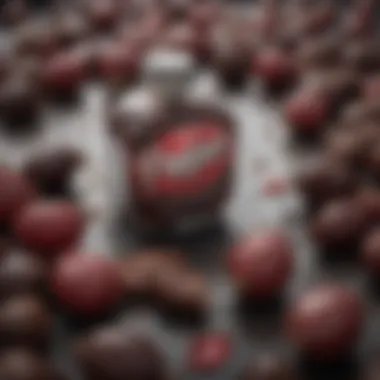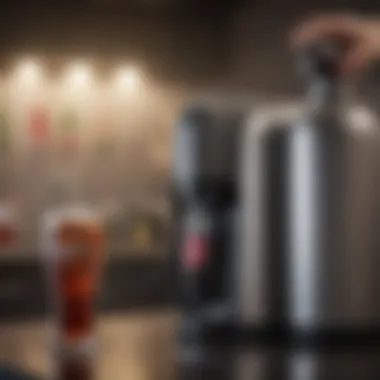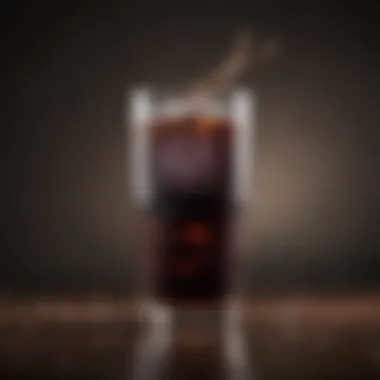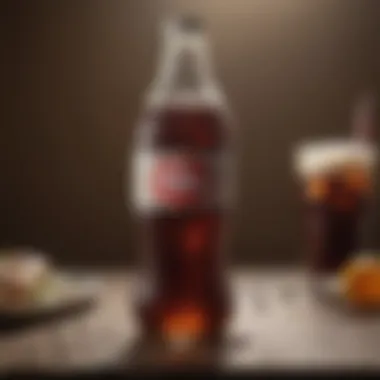Exploring Dr Pepper Soda Stream: A New Era of Homemade Beverages


Intro
The rise of home beverage production represents a significant shift in consumer habits. With advancements in technology, beverages that were once limited to store shelves are now becoming accessible for home preparation. In this context, Dr Pepper and Soda Stream intersect to offer a unique experience for enthusiasts and casual drinkers alike. This exploration looks at how creating Dr Pepper at home can modify not just the taste, but also the way consumers engage with their drinks.
By examining the ingredients, health implications, and consumer preferences, we aim to provide a comprehensive overview of this trend. The article will also highlight the broader cultural implications of homemade beverages in a market increasingly defined by personalized experiences.
Market Overview
The beverage market is evolving quickly. Many consumers prefer options that allow for customization and personal touch. Dr Pepper, known for its distinct blend of flavors, has the potential to thrive in this emerging landscape. Home soda machines, particularly Soda Stream, become tools for personalization.
Current Market Trends
Consumers are moving towards products that promote both health and convenience. The trend favors drinks with fewer preservatives and artificial ingredients. Soda Stream allows users to combine flavor syrups with carbonated water, signaling a preference for less processed options. Moreover, there is growing demand for craft beverages—this shifts focus to unique flavors like Dr Pepper’s diverse profile, making it attractive for home preparation.
Economic Indicators Impacting the Market
Economic conditions also play a role in shaping consumer choices. Rising inflation may prompt individuals to explore cost-effective alternatives to commercially bought drinks. Soda Stream presents an attractive option; it provides long-term savings when making beverages at home, appealing to budget-conscious shoppers.
Global Influences and Major Events
Global events also impact trends in the beverage sector. The pandemic heightened interest in home cooking and beverage preparation, causing many to invest in home soda machines. The push for sustainability also affects how consumers approach beverage production; many seek reduced packaging and environmentally friendly practices, which aligns with home beverage production.
"A shift in consumer culture towards homemade beverages may alter the landscape of the beverage market significantly."
In this new era, individuals are more than consumers; they are creators. This change has implications for brands like Dr Pepper, which must adapt to a consumer base seeking authenticity and uniqueness.
As we move forward, understanding these market dynamics becomes crucial. What does the future hold for Dr Pepper and Soda Stream? How will these trends influence health implications and consumer preferences? The upcoming sections will delve deeper into these inquiries.
Prelims to Dr Pepper and Soda Stream
Dr Pepper and Soda Stream represent two significant facets of the beverage industry. Understanding their convergence is key to appreciating the contemporary landscape of homemade drinks. This section explores the foundational elements of both Dr Pepper and Soda Stream, illuminating their histories, innovations, and cultural impacts.
History of Dr Pepper
Origins and Development
Dr Pepper is a soft drink that originated in the 1880s in Waco, Texas. Created by Charles Alderton, the drink was unique for its blend of 23 flavors. The initial development aimed to offer a distinct taste that set it apart from other sodas. This variety quickly attracted attention and contributed to its rising popularity.
A defining characteristic of Dr Pepper's origins is its secret recipe, which has been closely guarded over the years. The mystery has bolstered its allure, which remains appealing today. The development of Dr Pepper is not only a story of a popular soda, but also of an innovative approach to craft beverages.
Unique Recipe Elements
The recipe involves a mix of fruits, spices, and other flavorings that give Dr Pepper its distinctive profile. Key flavor components include cherry, vanilla, and a hint of almond. This combination makes it a favorite among soft drink enthusiasts.
The unique recipe contributes to Dr Pepper's identity in homemade beverage circles. For those attempting to create it through Soda Stream, understanding these elements is critical. The balance of flavors must be maintained to replicate the original. However, the complexity of the recipe could make it challenging for DIY enthusiasts.
Cultural Significance
Dr Pepper has established itself in American culture. Its branding and marketing have crafted a narrative that resonates with consumers, emphasizing authenticity and individuality. This cultural presence has led to a dedicated fan base, enhancing its status beyond mere refreshment.
The cultural significance extends to its role in social gatherings, often found at parties and events. This makes it a popular choice for home beverage production. However, replicating this cultural essence at home requires not only the right ingredients but also an understanding of Dr Pepper's place in popular culture.
The Rise of Soda Stream
Technological Advancements
Soda Stream has revolutionized the way consumers create carbonated beverages at home. Its technology allows users to carbonate water quickly and easily, making it an attractive option for DIY beverage production. By focusing on efficiency and ease of use, Soda Stream has become a staple in many households.
One of the significant advantages of this technology is the ability to customize flavors, allowing for exploration beyond traditional soft drinks. The convenience of having a Soda Stream machine facilitates the process of beverage creation, fitting well into modern lifestyles. However, this ease of use has also led to concerns about over-reliance on home carbonation tools.
Environmental Considerations


Soda Stream promotes itself as an environmentally friendly alternative to purchasing bottled soda. By allowing consumers to make their own carbonated drinks, it reduces plastic waste. The emphasis on sustainability resonates with many consumers today.
However, potential disadvantages include the need for regular purchasing of CO2 canisters. While the overall carbon footprint might be lower, ongoing purchases can contradict the initial environmental goal. Understanding this balance is crucial when evaluating the impact of Soda Stream.
Consumer Trends
There is a noticeable shift toward home-based beverage production among consumers. This trend is influenced by factors such as health awareness and customization preferences. Many people are seeking alternatives to traditional sugary drinks, looking for ways to enjoy their favorites in a more controlled manner.
Soda Stream aligns perfectly with these consumer trends. People desire the ability to create flavors at home while managing ingredients. Yet, this rise in interest also highlights the need for education about proper ingredient choices and potential health outcomes in DIY beverage creation.
Creating Dr Pepper with Soda Stream
Creating Dr Pepper with Soda Stream is integral to the overall theme of this article as it exemplifies how individuals can take control of their beverage choices. The process not only emphasizes creativity but also caters to the growing demand for personalized consumption experiences. By making Dr Pepper at home, consumers can experiment with flavors and adjust sweetness to their liking. This direct involvement in beverage creation links closely with health awareness and sustainability, thus reflecting broader consumer trends.
Required Ingredients
Key Flavor Components
The key flavor components of Dr Pepper are central to replicating its taste when using Soda Stream. This soda boasts a unique blend of 23 flavors, including vanilla, cherry, and licorice. Understanding these components is vital for achieving authenticity in homemade versions.
One distinct characteristic of these flavor components is their variety. Each element contributes to the overall complexity of the final drink. For example, the cherry flavor provides a fruity base, while the inclusion of spices adds warmth. This diversity is beneficial for consumers who appreciate a rich flavor profile. However, sourcing these ingredients can be challenging, as not all flavorings are readily available in stores. Yet, the effort involved can lead to gratifying results.
Synergies with Carbonation
The synergy between these flavor components and carbonation is crucial in creating the perfect homemade Dr Pepper. Carbonation enhances the sensory experience by offering a mouthfeel that elevates the beverage. The effervescence cuts through sweetness, making the drink feel lighter.
Moreover, the interaction between carbonation and flavors can intensify their impact. This unique feature allows for a more enjoyable drinking experience. Nevertheless, careful balancing is required. Over-carbonation may mask the subtle flavors, potentially diminishing the overall quality of the drink. The challenge lies in finding the right amount of fizz that complements the drink’s unique characteristics.
Available Alternatives
When considering available alternatives for making Dr Pepper with Soda Stream, it is important to acknowledge that multiple flavor concentrates exist. Brands offer various syrups that mimic the classic taste, making it easier for consumers to recreate the beverage at home. Using these alternatives can simplify the preparation process by providing a base flavor without the need to mix multiple ingredients.
The characteristic of these alternatives is their convenience. They allow for a quick and easy method to produce homemade sodas. While some consumers appreciate the ease this offers, others might find the taste lacks the depth found in traditionally made versions. The unique feature of having premade flavoring options does offer the benefit of consistent flavor delivery, which might appeal more to casual consumers than to hardcore enthusiasts.
Step-by-Step Preparation
Setting up the Soda Stream
Setting up the Soda Stream properly is vital for effectively creating Dr Pepper. A well-configured machine ensures optimum carbonation levels, which are essential for achieving desired results. Understanding the manual and aligning the components correctly can lead to a more efficient process.
The simplicity of this setup allows users to make drinks quickly, which is a considered benefit for busy lifestyles. However, improper assembly can lead to issues, such as leaks or insufficient carbonation. Therefore, paying close attention to setup details is critical for a successful experience.
Mixing Ingredients Precisely
Mixing ingredients precisely is another fundamental aspect of crafting Dr Pepper with Soda Stream. Achieving the right balance between flavors involves meticulous measuring and attention to the combination ratios. If the proportions are off, the resulting beverage may not reflect the intended taste.
This precise mixing characteristic provides a higher degree of control for the user. It fosters creativity, allowing individuals to modify recipes based on preferences. Nevertheless, the downside is the potential for inconsistencies if measurements vary from batch to batch.
Achieving Desired Fizz Level
Achieving the desired fizz level is an essential step in the preparation process. The right carbonation level enhances the overall experience of drinking the beverage. Too little fizz can lead to flatness, while excessive carbonation may overwhelm the taste.
The ability to adjust fizz provides significant flexibility for consumers. They can tailor their drinks to personal preferences. However, monitoring carbonation levels can be tricky for novices, and too much focus on achieving fizz might sidetrack them from other essential aspects of preparation. Ensuring a balance between fizz and flavor is key to creating a pleasing homemade Dr Pepper.
Taste Profile and Quality Analysis
The exploration of taste profile and quality analysis is crucial for understanding the experience of creating Dr Pepper using Soda Stream. This section delves into how flavor profiles are shaped during homemade beverage creation and the overall quality perceived by consumers. Evaluating taste helps individuals gauge their satisfaction, while quality analysis reflects on the ingredients used, preparation methods, and the end product's marketability.
Comparative Taste Testing
Home vs.


Commercial Production
The comparison between home and commercial production offers insights into making Dr Pepper at home. Home production allows for customization, enabling users to adjust flavors, sweetness, and carbonation to personal preference. This flexibility is a critical characteristic, as it leads to individual satisfaction. However, achieving the same complexity as commercial versions can be challenging. Home recipes must strike a balance, ensuring that the essence of Dr Pepper is maintained while allowing a personal touch.
Flavor Consistency
Flavor consistency is another essential aspect, addressing how uniform the taste remains across different batches. In commercial production, Dr Pepper's flavor is meticulously maintained through controlled processes and recipe adherence. This consistency makes it a popular choice among consumers who expect the same experience every time. Conversely, homemade versions might experience variations. While this introduces uniqueness, it may disappoint those seeking predictability.
Consumer Preferences
Consumer preferences reflect changing trends in beverage consumption. Many people now favor homemade options due to perceived health benefits and personalization. This choice shows a shift towards independence in beverage creation, aligning with current market demands. However, some consumers still prefer the reliable flavor and experience of a commercially produced Dr Pepper. Understanding this dichotomy is crucial for evaluating the success of homemade alternatives.
Sensory Evaluation
Aroma Depth
Aroma depth plays a significant role in the overall appeal of Dr Pepper. The scent can evoke memories and emotions, enhancing the drinking experience. A well-crafted homemade version should aim to replicate the unique aroma profile of Dr Pepper, which includes hints of various spices and fruits. This link to taste makes aroma a key factor in the quality assessment of the beverage. However, achieving the correct balance may require experimentation.
Aftertaste Assessment
Aftertaste assessment involves evaluating the lingering flavors after ingesting the beverage. This aspect can dramatically influence overall satisfaction. Dr Pepper is known for its distinct aftertaste, which can vary from sweet to spicy, depending on the formula. Homemade versions may not always replicate this profile accurately, leading to varied consumer reactions. A successful balance in aftertaste can significantly improve the homemade experience.
Overall Satisfaction Metrics
Overall satisfaction metrics gauge how consumers feel about their homemade Dr Pepper compared to store-bought versions. Factors such as taste, texture, and smell come into play. Users often express satisfaction when they successfully recreate their favorite beverage. However, variables like ingredient quality and preparation methods can lead to disappointment. Thus, it is essential to consider these metrics when discussing the future of home beverage production.
Health Considerations
Understanding health considerations when creating Dr Pepper with Soda Stream is essential. It helps consumers to make informed choices. This section will delve into nutritional aspects, as well as the impacts on lifestyle choices, shedding light on advantages and disadvantages associated with homemade beverages.
Nutritional Content
Caloric Comparison
Caloric content is a significant factor when assessing the healthiness of beverages. When comparing homemade Dr Pepper to commercially available versions, caloric values can be notably lower. It allows for better control over the amount of sugar and other ingredients used. Homemade preparations often result in lower calories. This can be especially appealing for individuals monitoring their weight or looking for a healthier drink option. However, the unique feature of homemade versions is the flexibility in creating satisfying flavors without accumulating excessive calories.
Sugar Content Analysis
Sugar content is a critical aspect of soda consumption. Analyzing sugar levels gives insight into overall health implications. Many commercially produced Dr Pepper drinks contain high levels of added sugars, known to contribute to various health issues. In contrast, using Soda Stream allows for customizing sugar levels according to personal preference. This level of control can decrease the risk of health problems such as obesity and diabetes. However, one must be cautious, as even homemade versions can have high sugar content if not properly managed.
Artificial Ingredients Scrutiny
Artificial ingredients are frequently found in store-bought sodas. Scrutinizing these elements is vital for those prioritizing health. Homemade versions can avoid using these additives, providing a cleaner beverage. The absence of artificial ingredients is a key characteristic of homemade Dr Pepper, making it a safer alternative. Yet, it's necessary to be aware that some flavor enhancers and preservatives, even if made at home, should be used sparingly to retain health standards.
Impacts on Lifestyle Choices
Soda Consumption Patterns
Soda consumption patterns are shifting due to rising health awareness. Many consumers are opting for low-calorie or homemade options instead of traditional sugary sodas. This transition signifies a broader move towards a mindful approach to beverage consumption. Individuals increasingly seek beverages that align with their health goals. However, with the switch to homemade, some may find it less convenient than grabbing a bottle from the store.
Homemade Alternatives
Homemade alternatives have gained popularity due to their adaptability. Many consumers prefer crafting beverages at home for various reasons—taste, control of ingredients, and cost considerations are essential. Creating Dr Pepper with Soda Stream highlights this trend. Yet, one unique feature is that making soda is different than grabbing somewhere. Some might find it takes more time and effort than buying ready-made options.
Long-term Health Implications
Long-term health implications of beverage choices cannot be overlooked. Regularly consuming high-sugar drinks establishes patterns that may lead to chronic health issues. By shifting towards homemade options, consumers can potentially reduce their long-term health risks related to diet. Educational awareness surrounding these implications can guide better choices for individuals. Nonetheless, one must remain vigilant about ingredient choices to realize the full benefits over time.
In summary, health considerations related to the creation of Dr Pepper with Soda Stream are vast. Evaluating nutritional content, considering lifestyle impacts, and identifying long-term health implications is essential for a well-rounded perspective.
Consumer Behavior and Trends


Understanding consumer behavior and trends within the context of Dr Pepper and Soda Stream is crucial. The dynamics of how people make beverage choices, particularly in homemade production, reflect broader societal shifts. In this section, we will explore the motivations behind a shift to home-based beverage production, market trends, and the economic implications for consumers.
Shift to Home-based Beverage Production
Motivations Behind DIY Drinks
The rise of DIY drinks can be attributed to several factors. People are increasingly conscious of ingredients and seek control over what they consume. This control allows them to avoid unwanted additives and tailor flavors to their preferences. Home production of beverages promotes a sense of personalization. Moreover, many find the process of creating drinks rewarding, adding an element of fun to their routine.
In this article, the key characteristic of Motivations Behind DIY Drinks is centered on the empowerment it gives individuals. Consumers enjoy the knowledge that they can craft a drink just like Dr Pepper in their own kitchen. This choice is beneficial as it fosters creativity and self-reliance. However, some may find the initial learning curve a bit daunting, potentially discouraging new users.
Market Trends
The market for home beverage systems is expanding rapidly. Many consumers are seeking alternatives to commercial sodas. This shift is driven by a combination of health consciousness and a desire for unique flavor combinations. The trend indicates a growing preference for customization in the beverage space.
Key trends highlight the increased interest in carbonation systems. This makes choices like Soda Stream particularly appealing to those who want to replicate classic flavors at home. Although the upfront investment may deter some, the long-term savings on store-bought sodas are significant.
Consumer Economics
Another essential aspect to explore is Consumer Economics. The desire for homemade beverages often aligns with budget considerations. With rising costs of store-bought drinks, many consumers are looking for more affordable options. By using a Soda Stream and making Dr Pepper at home, individuals can significantly lower their beverage expenses over time.
The key characteristic of Consumer Economics in this context is cost-effectiveness. This makes it an attractive choice for families and individuals who want to manage their expenses. The unique feature is how quickly the initial cost of equipment can be offset by savings on future purchases. However, the ongoing need to replenish flavor syrups may represent a hidden cost for some.
Cultural Shifts in Beverage Consumption
Social Aspects of Sharing
Sharing beverages is an integral part of many social gatherings. Homemade drinks often create a more inviting atmosphere. When consumers craft their own beverages, it fosters interaction and conversation. The art of mixing drinks at home can enhance the social experience at gatherings. This investment in time and effort is seen positively in social contexts.
The key characteristic of the Social Aspects of Sharing lies in community building. Consumers feel a sense of belonging when sharing their homemade creations. However, the effort required to prepare drinks may not always appeal to everyone, potentially leading to missed opportunities for some.
Home Entertaining Trends
In recent years, there has been a notable shift towards home entertaining. As people gather more at home, unique beverages become a focal point of social interaction. By providing innovative drink options like Dr Pepper made with Soda Stream, hosts can elevate the dining experience. This trend highlights the willingness of consumers to invest in home experiences instead of going out.
The key aspect here is the experiential value that home entertaining provides. It encourages creativity in planning gatherings. However, it may require more preparation time, which could be a barrier for some individuals.
Sustainability Considerations
Sustainability is an increasing concern for consumers today. More people are evaluating the environmental footprint of their choices, including beverages. The shift to home production can lessen waste, as it reduces the reliance on single-use bottles and cans. By using systems like Soda Stream, consumers can craft their drinks in a more environmentally responsible way.
A key characteristic of this trend is eco-friendliness. This choice aligns with many consumers' goals to reduce their impact on the planet. The potential downside may be the initial purchase costs, which might deter some from engaging in more sustainable practices, but the long-term benefits often outweigh these concerns.
Understanding these consumer behaviors and trends helps illuminate the broader implications of homemade beverages, particularly through the lens of health, taste, and environmental consciousness.
Finale
In this exploration of Dr Pepper and Soda Stream, we highlight the intricate relationship between a beloved beverage and innovative technology. The intersections of flavor innovation, health considerations, and evolving consumer preferences are central to this narrative. Each element plays a vital role in understanding the resulting homemade beverage experience.
Summary of Findings
Key Takeaways on Quality and Health
Homemade Dr Pepper using Soda Stream presents notable benefits. The control over ingredients allows for healthier versions, reducing sugar content significantly compared to conventional commercial options. The unique aspect here is the empowerment of consumers to tailor sweetness and flavor intensity. This adaptation makes it a more appealing choice for health-conscious individuals, fostering an environment where quality is prioritized. Understanding these health-oriented decisions illuminates the broader tendencies toward personalized food and beverage production.
Consumer Insights and Future Directions
Consumer behavior continues to shift, favoring personalized experiences. This trend is evident in the growing popularity of home beverage systems, where individuals can adapt their drinks to suit personal tastes. The distinct characteristic of this trend is its capacity to democratize beverage production, moving away from mainstream choices. As new flavors and customizable options evolve, this personalization enriches the overall drinking experience while also highlighting sustainability practices that resonate with modern consumers. Approaching beverage choices with creativity leads to a more dynamic future.
Potential for Innovation
Future of Home Beverage Systems
The future of home beverage systems appears promising, with advancements in technology that enhance user interaction. The primary appeal lies in convenience, enabling consumers to craft beverages efficiently at home. This inclination toward automation can translate to increased interest in unique flavor profiles and healthier alternatives. However, challenges regarding consistency in taste and user experience remain. Resolving these matters will be crucial to solidifying the market presence of home beverage systems.
Opportunities for New Product Development
Innovation always drives opportunities for new product development, particularly in the context of soft drinks. Companies can explore flavor combinations and natural ingredients to cater to diverse tastes. The beneficial facet is that this aligns with rising consumer demands for bespoke and healthier beverages. Yet, balancing creativity with consumer expectations can be complex. Potential avenues for exploring unconventional ingredients may offer unique market advantages but may also require careful market research to ensure demand.
As consumers embrace homemade beverages, the landscape of soft drink consumption will continue to evolve, promising exciting innovations in the near future.



